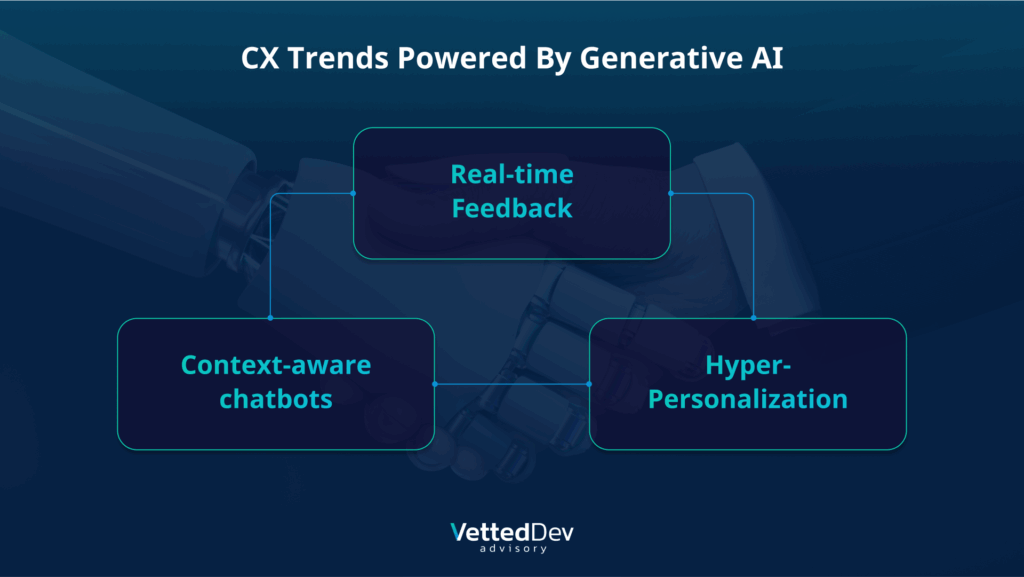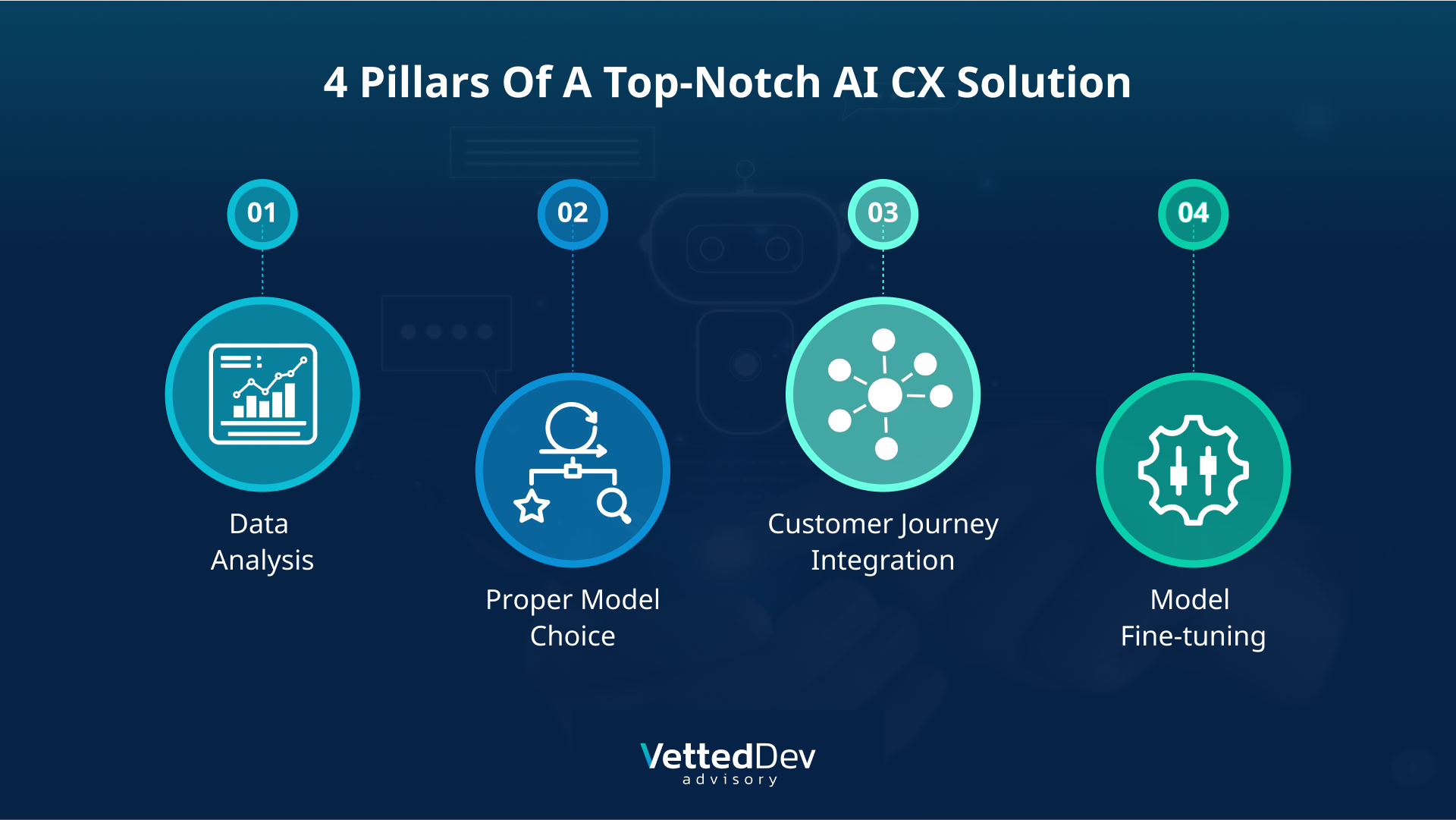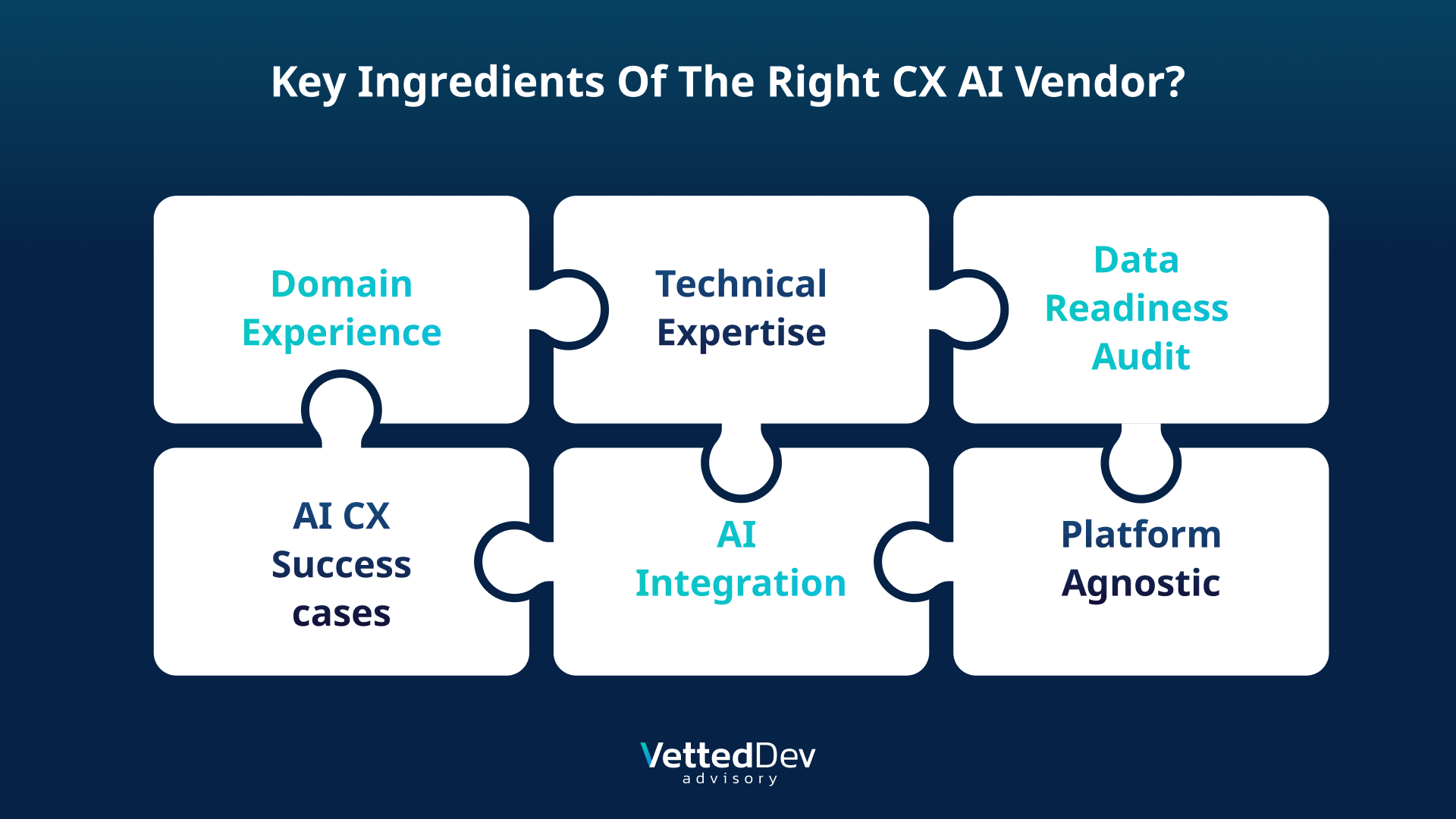Generative AI in Customer Experience: A Game-Changer That Demands the Right Vendor in 2025
By VettedDev.net
Introduction
The rise of generative AI has rewritten the rules of customer engagement. From hyper-personalized content to intelligent virtual assistants that actually “get” your customers, AI promises a revolution in how businesses interact with their audiences. But here’s the problem: every software company now claims they’re an AI company.
As a business owner or C-level executive sitting on significant investment capital, you already know what’s at stake. You’re not just looking for a slick chatbot or another predictive model. You want a bespoke, AI-driven solution built for your unique customer journey, data assets, and business model. And frankly, that’s hard to come by in a market full of smoke and mirrors.
In this article, we’ll explore how generative AI is genuinely transforming customer experience (CX), why so many companies get it wrong, and how you can identify the right development partner who can deliver on this promise without wasting time, budget, or trust.
Why Generative AI is More Than a Buzzword in 2025
The hype has legs. Generative AI tools like GPT-4, Claude, and custom-trained foundation models are changing how businesses create, automate, and personalize content.
In 2025, we’re seeing three dominant CX trends powered by generative AI:
1. Context-Aware Conversations
Today’s customers expect conversations and not transactions. Generative AI enables context-aware chatbots and voice assistants that maintain memory, adapt tone, and personalize dialogue over time. These are not your average “reset-on-every-interaction” bots.
Imagine a fintech customer service assistant that recalls the customer’s last three account issues, recognizes spending trends, and suggests personalized financial advice in real time. That’s not a script; that’s a strategic asset.
2. Hyper-Personalization at Scale
Thanks to deep learning and generative architectures, content (emails, offers, support responses, even entire web pages) can now be dynamically generated for segments of one.
E-commerce brands are using AI to craft unique product descriptions based on user behavior. Healthcare providers are generating customized post-appointment care instructions. SaaS companies are sending AI-generated onboarding flows tailored to individual user actions.
This kind of personalization used to require a whole team. Now it’s achievable with the right tools.
3. Next-Level Feedback Loops
Generative AI doesn’t just push information it learns from it. Businesses are using real-time feedback loops from customer interactions to fine-tune marketing copy, adjust product offerings, and even retrain support bots on the fly.
In essence, the customer is now a co-designer of the experience.

But Here’s the Catch: Most Vendors Can’t Build This Right
Let’s get brutally honest. AI is hard. Generative AI? Even harder.
While the market is flooded with agencies slapping “AI-driven” or “machine learning experts” on their landing pages, very few have the actual expertise to build custom, production-grade AI solutions. Especially those that are deeply integrated into customer experience pipelines.
We’ve reviewed dozens of vendors claiming they can “do AI,” and here’s what we consistently find:
- Off-the-shelf integration masquerading as custom work.
- Lack of understanding of model training and fine-tuning.
- No experience in prompt engineering or retrieval-augmented generation (RAG).
- Limited attention to data infrastructure, privacy, or ethical deployment.
For a project that could influence your brand’s entire customer perception and ROI. This is risky territory.
The Real Anatomy of a Custom AI-Driven CX Solution
To separate the real experts from the rest, it helps to understand what a true custom AI CX solution involves. Here’s a high-level breakdown:
✅ 1. Data Strategy First
Great AI needs great data. A reputable vendor will start by analyzing your data pipelines—CRM systems, support tickets, customer journey maps, marketing analytics and mapping them to potential AI models.
They’ll ask:
- What are the data silos and quality issues?
- Is synthetic data needed for training?
- What privacy or compliance constraints exist?
If your vendor isn’t spending 20–30% of the project on data readiness, that’s a red flag.
✅ 2. Model Selection, Customization & Fine-Tuning
Off-the-shelf GPT-4 or Claude models are powerful—but generic. For real business value, the model often needs to be:
- Fine-tuned on your data.
- Combined with RAG for up-to-date knowledge.
- Wrapped with safety layers to control tone, hallucinations, and edge cases.
A real AI partner will be comfortable working across Hugging Face, OpenAI APIs, AWS Bedrock, or even building LLMs from scratch when needed.
✅ 3. Seamless Product Integration
It’s not enough to build a model—you need to integrate it into your actual product or customer journey:
- Chat widgets that speak to your backend in real time.
- Recommendation engines embedded into your e-commerce platform.
- AI assistants that plug into Slack, email, or your helpdesk platform.
This requires serious engineering chops beyond AI knowledge. You want a full-stack AI vendor—not just a data science team.
✅ 4. Monitoring, Feedback Loops, and Iteration
AI isn’t one-and-done. A smart vendor will build tools to:
- Monitor how the AI is performing across CX metrics.
- Collect and label user feedback (automatically, if possible).
- Retrain or fine-tune the model periodically to improve.
Without these steps, your AI solution will degrade over time. Or worse—become a liability.

AI CX Success Stories (Done Right)
Let’s ground this in reality. Here are some actual use cases that reflect how the best vendors deliver generative AI value in customer experience:
🌐 B2B SaaS: Smart Onboarding & Customer Support
A high-growth SaaS company used generative AI to build a dual-mode assistant: onboarding help and tier-1 support. The assistant learned from product docs, support tickets, and user behavior, reducing support volume by 45% while improving NPS.
This only worked because the vendor:
- Mapped the entire customer journey.
- Used RAG to keep the assistant’s knowledge fresh.
- Set up escalation logic to live agents with full context.
🛍️ Retail: Personalized Shopping Concierge
An online retailer integrated an AI agent that adapted its tone and recommendations based on browsing history, past purchases, and even time-of-day behavior. The result? 28% increase in AOV (average order value).
The AI model was fine-tuned on brand voice and integrated with inventory and pricing APIs to make real-time, relevant suggestions.
🏥 Healthcare: Patient-Centric Information Delivery
A health tech platform used generative AI to deliver personalized care instructions and appointment follow-ups. Messages adapted based on diagnosis, treatment plans, and patient literacy levels.
This required:
- Advanced NLP for medical language.
- Robust privacy architecture.
- Human-in-the-loop QA for model safety.
How to Choose the Right Vendor (No BS Checklist)
If you’re a business leader looking to deploy custom generative AI in 2025, the right vendor could mean millions in saved costs or increased revenue. The wrong one? A blown budget and a loss of customer trust.
Here’s your no-fluff checklist:
✅ Do they show domain understanding?
If you’re in finance, healthcare, SaaS, or retail—do they understand the specifics of your customer experience?
✅ Can they explain the difference between LLM fine-tuning and prompt engineering?
This is basic, and a great filter question.
✅ Do they offer a data readiness audit?
If not, they’re probably skipping the hardest (and most crucial) part of the project.
✅ Do they demo past projects with measurable CX impact?
No vague dashboards—show us the NPS lift, the churn reduction, or CSAT delta.
✅ Do they integrate AI into your actual workflows?
Or are they just handing you a model in a sandbox?
✅ Are they independent of platforms?
Beware of vendors pushing only OpenAI, Google, or Microsoft because that’s what they know. You want a partner, not a product pusher.

Final Thoughts: It’s Not Just About AI, It’s About Trust
In 2025, trust is the real differentiator in the AI CX landscape.
Not just trust between you and your customers—but between you and the vendor building the system that talks to them. That’s why at VettedDev, we specialize in independent consulting and vendor selection for businesses serious about AI.
We don’t build the software ourselves—we help you find the right team that does. We speak the language of AI, but we also speak business. So if you’re staring at a dozen vendor decks with “transformative AI” promises and wondering who’s legit—we’re here to cut through the noise.
Let’s make sure your next AI-powered customer experience is not only impressive—but built to last.
Looking for a trusted AI development partner?
Let’s talk. We’ll help you vet the right vendors, challenge the tech assumptions, and ensure your investment delivers.
Looking for more insights on finding the right outsourcing partner? Visit VettedDev.net for guides, tips, and curated recommendations.
